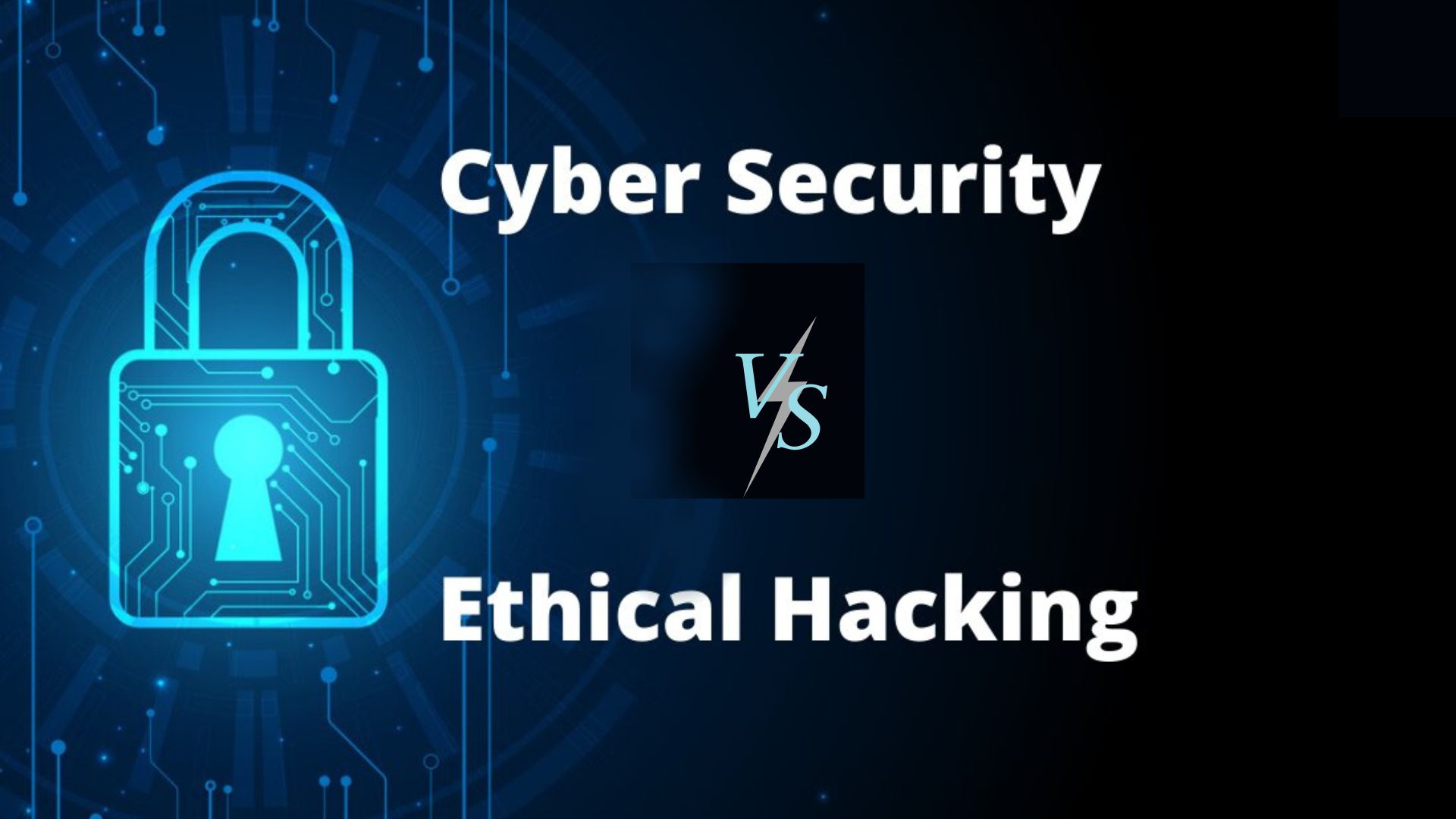Many organizations today rely on cybersecurity and ethical hacking to protect themselves from falling victim to cyber-attacks. Both cybersecurity and ethical hacking serve similar purposes of improving a company’s security but they differ in a lot of ways. While cyber security is a broader domain, ethical hacking is a part of cybersecurity. It is important for any organization that is investing in a security framework to understand each of these terms. In this blog, we will understand the difference between cyber security and ethical hacking.

Cyber Security vs. Ethical Hacking : Ultimate Comparison Guide
Cyber Security vs. Ethical Hacking : Ultimate Comparison Guide
Many organizations today rely on cybersecurity and ethical hacking to protect themselves from falling victim to cyber-attacks. Both cybersecurity and ethical hacking serve similar purposes of improving a company’s security but they differ in a lot of ways. While cyber security is a broader domain, ethical hacking is a part of cybersecurity. It is important for any organization that is investing in a security framework to understand each of these terms. In this blog, we will understand the difference between cyber security and ethical hacking.
Before we explore the difference between cybersecurity and ethical hacking, let us understand the terms cyber security and ethical hacking.
Definition of Cybersecurity
Cyber security is the practice to defend internet-connected systems, such as hardware, software, programs, and data from damage, malicious attacks, or unauthorized access. It helps prevent cybercriminals from gaining access to data, systems, or networks. Cyber security is a broad subject that includes many security mechanisms, such as data security, ethical hacking, and digital forensics.
Cyber security can be categorized into the following:
Application Security
Cloud Security
Data Security
Endpoint Security
Information Security
Identity Management
Mobile Security
Network Security
With cyber threats continuing to evolve globally, every organization, especially those involved in safeguarding sensitive data needs to take appropriate steps to protect their sensitive information.
Definition of Ethical Hacking
Ethical hacking is a subset of cybersecurity. It refers to the process of testing the system against potential security breaches or data threats and repairing the flaws before any cyber attack happens. Ethical hacking involves finding vulnerabilities and weak points that cybercriminals can exploit.
Ethical hackers are also known as white-hat hackers. White hat hackers work similar to black-hat hackers but with a different intent. White hat hackers use their skills to find the loopholes of the given system with permission from the server/system admin. They do not want to harm anyone with their acts rather they safeguard the systems.
What Does Ethical Hacking Mean?
Ethical hacking is part of cybersecurity, used as an application for security and network controls. Ethical hacking is a type of hacking done for a positive purpose, not to harm anyone. It is also done in response to negative hacking or potential security breaches.
Ethical hacking, being a subset of cybersecurity, mainly focuses on determining vulnerabilities within the organization’s system or network. It also resolves any malicious activity going on within the system.
Ethical hacking includes testing and validating processes to identify the weakness or any malicious activity on the system. It informs the organizations about the flaws, and on approval of the organization to develop solution strategies, penetration testing is done.
Benefits of Ethical Hacking
There are many benefits of ethical hacking. It is a broad field with a systematic and proactive approach to mitigating risks and eliminating any malicious happenings on the system.
Some of the major benefits of ethical hacking are:
Ethical hacking helps provide a solution for any vulnerabilities happening in the system or network of an organization.
It protects the data and valuable information of an organization from being stolen or lost due to cyber theft or cyber-attacks.
Regular assessments are done to track the current security control status.
Penetration testing is followed to resolve any vulnerability and further build a strong security system.
It prevents potential attackers from drawing meaningful insights into the security posture of the organization.
Different Types of Ethical Hackers
Ethical hackers do ethical hacking. They are popularly known as white hat hackers, “the good guys.”
Some of the major types of ethical hackers are:
White hat hacker: White hat hackers have knowledge of extensive computer networks and operating systems. Their work is to do hacking and prevent hacking of the system or network of private or government organizations. They seek to protect businesses and support them by providing solutions.
Black hat hackers: These types of hackers are cybercriminals who violate the cyber law and enter forcefully into other’s computer networks using inappropriate methods like phishing, SQL injection, etc.
Grey hat hacker: Such types of hackers break into any IT network without owners’ consent and follow malicious activities.
Blue hat hacker: This type of hacker mainly targets security firms that have been in contact with businesses to check their cyber and security systems. Sometimes, they are also motivated by any kind of revenge or desire to seek into others’ systems for any personal or professional gain.
Red hat hackers: Red hat hackers are very skilled ones who government agencies mostly hire to support them and protect them against black hat hackers.
A Comparison Table: Ethical Hacking vs. Cyber Security
Differences Between Ethical Hacking vs. Cyber Security
To further understand how ethical hacking vs. cyber security differs on a wider scale, have a look at the following points to get a better idea.
1. Work Responsibility
Ethical Hacking
Ethical hacker’s key responsibilities are:
Performance evaluation of the system.
Tests the network and security system of the organization.
Follow penetration testing if required.
Suggest insights and solutions to improve security systems.
Inform the owner in case any malicious activity is confirmed.
Identifies weaknesses of the system.
Use different modes of hacking to prevent security control.
Generate reports of all the vulnerabilities found in the system.
Cyber Security
Cybersecurity professionals monitor, detect, analyze, and respond to the security system. They protect security systems by evaluating risks and threats happening within the system.
Following are some key responsibilities:
Enhances the security system.
Work with the IT team to manage the integrity of the network and data in the organization.
Analyses security control and gives suggestions in those regards.
Updates security systems regularly.
2. Main Objective
Ethical hacking vs. cyber security differs majorly based on their objectives.
Ethical Hacking
The main aim of the ethical hacker is to improve the network safety and security systems of the organization.
They do so by ensuring that all the vulnerabilities are addressed properly while testing.
They use many methods and tools to enhance the security system against the access of unauthorized users.
Cybersecurity
Cybersecurity professionals protect sensitive data and information of the organization against any data breach or cyber theft.
It focuses on protecting system and computer networks from any intrusion or unauthenticated access.
3. Methods Used
Ethical hacking vs. cyber security use different methods and techniques to carry out their operations.
Ethical Hacking
Ethical hackers use the following techniques to do their daily responsibilities.
Phishing
SQL injection
Cryptography
Social engineering
Sniffing
Session hijacking
Enumeration
Foot-printing
Cybersecurity
The following are some methods used by cybersecurity professionals:
Cybersecurity critical infrastructure
Cloud Security
Application security
Network security
Internet of Things (IoT)
Encryption tools
Firewall tools
Web vulnerability scanning tools
Penetration testing
Network security monitoring tools
Packet sniffers
4. Process
Both ethical hacking vs. cyber security undergo a certain process and have a clear roadmap.
Ethical Hacking
The ethical hacking process is about finding and leveraging vulnerabilities for organizations’ benefit. An ethical hacker follows different stages:
Reconnaissance – Collects information about networks and systems.
Scanning – The system applies all the collected information to find weaknesses. Basically, scanning is done with the help of obtained data.
Acquiring access – At this stage, hacking starts. Ethical hackers target and attack to enter the system. After getting access, they try to manage the information and modify the codings.
Maintaining access – Access is maintained for a long time. The re-enter code is set to make it accessible in the future, too.
Clears the track – To prevent detection, hackers need to cover all their tracks and modify the codes.
Reporting – After successfully stimulating the cyber attack, ethical hackers prepare a report on vulnerabilities and problems addressed during the process.
Cybersecurity
Determines the problem on the network or system
Take measures to secure the system
Monitors regularly to identify any cyber threat
Resolves and handles incidents
Recover data in case there is a data breach due to cyber attacks
The Bottom Line
The Ethical hacking vs. cyber security industry requires a broad spectrum of knowledge and skills. It needs better familiarity with operating systems, networks, and technical tools. The cybersecurity field validates the identity and detects if there is any malicious activity going on.
Ethical hacking is a part of cybersecurity that goes through various testing and scanning processes to check if there is a vulnerability in the system. Now that you understand both the ethical hacking and cybersecurity field, directly and indirectly, work to protect your organization’s systems and networks. It is necessary to understand its importance and know its future prospects.






